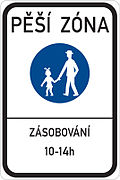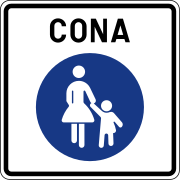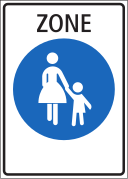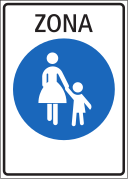Talk:Tag:highway=pedestrian
Just added area=yes support to t@h. Morwen 10:40, 1 December 2007 (UTC)
Cycling on a highway=pedestrian
Likely the law is different in every country so we could try to assemble a list of whether cyclists are not tolerated, tolerated, allowed or designated to drive on any highway=pedestrian roads and if there are any other requirements.
You can split the entries in (a)/(b), since a highway=pedestrian can be something that is known in the legal text as a "walking street" (or your local equivalent wording) or just a road that is in all other senses a pedestrian highway
| Country | Cyclists allowed by law | Cyclists must give unobstructed passage to pedestrians | Maxspeed | Motorcars ever allowed? | Pedestrians may not "unnecessarily obstruct" any vehicles |
|---|---|---|---|---|---|
| Belgium | Depends on the traffic sign | Cyclists cannot obstruct pedestrians and vice versa | No rule, should just be careful for pedestrians | Depends on the traffic sign | Yes |
| Finland | (a): Specifically yes, (a2) is not used (b):Yes or unknown |
(a): Yes (applies to drivers of all vehicles) (b): Normal caution |
(a): "Adjusted to pedestrians and not exceed 20" (b): National limit + normal caution? |
(a): When the only possible route to destination (b): only with additional signs (mostly present for service or destination traffic, though) |
Yes |
This won't yet be an attempt to define these to be the defaults for any country, we could seek to make a summary once we have enough data.Alv 07:11, 15 October 2008 (UTC)
footway vs pedestrian
Vovkav 09:05, 16 February 2010 (UTC): When should Tag:highway=pedestrian and not Tag:highway=footway be used? Should not we merge these two?
- The physical difference is that highway=pedestrian is a road that previously was a normal street (in city environments, mostly), or it is a Town square. Alv 09:14, 16 February 2010 (UTC)
Vovkav 07:09, 24 April 2010 (UTC): And what if the editor doesn't know if it was, or was not? What about 2 otherwise identical roads, that are different in their history? Is there anyone who needs visually distinguished history of the road? And still - do we need that ambiguity?
- The result is that the structure/look is different. Well, sometimes pedestrian roads have been built as such from the beginning, but they are similar to those that were previously proper roads. Alv 08:02, 24 April 2010 (UTC)
| footway | pedestrian | living street |

|

|
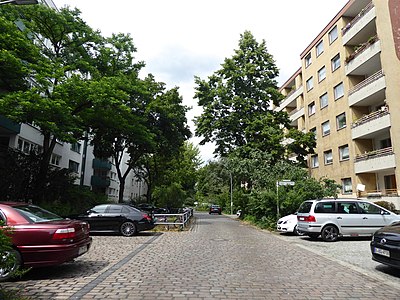
|
Vovkav 09:32, 24 April 2010 (UTC): damn. Are there any objective, history- and surrounding- independent criteria to tell pedestrian from footway?
- As stated on the page, main criteria is that road is as wide as normal (designated for vehicles) one, so vehicles pass it easily. --Vovanium 22:38, 2 May 2010 (UTC)
Nickvet419 ![]()
![]() 05:00, 6 February 2021 (UTC): I'm wondering now what is the difference of a pedestrian road and a highway=living_street?
05:00, 6 February 2021 (UTC): I'm wondering now what is the difference of a pedestrian road and a highway=living_street?
- Cars are allowed on living street (though pedestrians have priority, may use any part of a road and speed limit is extremely low), while cars are banned completely or mostly on highway=pedestrian Mateusz Konieczny (talk) 06:38, 6 February 2021 (UTC)
- Yes, a living street is typically a residential road with very low speed limit (e.g. in Germany walking speed, court has confirmed that it is below 10km/h, so literally the speed of a pedestrian) and kids playing on the road (is allowed), while a pedestrian street is typically in a retail area (is not a must) and vehicles are banned, although there may be exceptions, e.g. for specific loading and delivery hours, for taxis, police etc. Even bicycles are banned by default in many jurisdictions. --Dieterdreist (talk) 21:48, 15 February 2021 (UTC)
ways towards apartment buildings
- the description of highway=pedestrian sounds like, it's meant for bigger streets only. what about ways that lead towards apartment buildings, which are mainly for pedestrians, but broad enough for motorcars and emergency vehicles. normally there are one or two pollards, which can be tilted, so cars can enter if the owner permits it. footway doesn't fit in such a case and highway=service indicates a primary usage for vehicles. i suggest to use highway=pedestrian + an additional tag pedestrian=apartments. --Flaimo 14:52, 5 June 2011 (BST)
" and make connecting nodes at all intersections with the pedestrian area"
This phrase was missing in older Russian translation. Who added this text and why there need in common points? Xxzme (talk) 00:26, 8 November 2014 (UTC)
"For town centres and civic areas"
highway=pedestrian is also used to tag roads used exclusively for pedestrians (or nearly exclusively) in forests and other areas - not only in city centers. For an example see Aleja Wędrowników in Kraków (photoosm) I propose following description:
"For roads mainly / exclusively for pedestrians. Typical in shopping areas, town centers, places with tourism attractions and recreation/civic areas, where wide expanses of hard surface are provided for pedestrians to walk."
to replace current
"For town centres and civic areas, where wide expanses of hard surface are provided for pedestrians to walk (often between shops)."
Mateusz Konieczny (talk) 10:05, 28 June 2015 (UTC)
- The definitions is good. But your new example picture of a cementary is problematic: Every cementary is pedestrian-only, these ways could probably not serve as a normal road. A wide footway through a cementary does not make a pedestrian zone imho. What distinguished the pedestrian ways from the footways on this cementary?--Jojo4u (talk) 16:34, 14 November 2015 (UTC)
- I agree with Jojo4u that the cemetery example is misleading, as it blurs the distinction between footway and a pedestrian zone/area in the town centre. The particular example depicted is probably a highway=service with appropriate access rights (access=private + foot=yes); typically on a cemetery this also functions as the driveway for maintenance and mourning vehicles. Otherwise, a wide footway is still a footway which can be given width=*. --Polarbear w (talk) 11:00, 1 November 2017 (UTC)
- As always it depends. There are big cemeteries where there is a clear distinction between main roads and smaller side paths or roads, and it would seem desirable to have some kind of hierarchy to represent the structure. The term "highway=pedestrian" is not requiring to be in an actual "pedestrian zone" (although it applies there as well, of course), it is mainly a distinction between smaller footways and larger, main pedestrian ways. Also, small footways within a pedestrian zone still are footways and not pedestrian highways. --Dieterdreist (talk) 10:05, 2 November 2017 (UTC)
- "these ways could probably not serve as a normal road" - these ways would be able to be used as a normal road. In fact, this one from example is used as a service road for maintenance and is constructed like normal road. highway=pedestrian is still better than highway=service as it is primarily used by pedestrians. Also, an extremely wide footway is distinguishable from "road converted into pedestrian area" only by history Mateusz Konieczny (talk) 15:31, 2 November 2017 (UTC)
I'm not happy with the situation, as we are losing the distinction between the =footway and =pedestrian value. It seems we agree that
- the 1,50 m wide way on the picture above is =footway
- the previous city road that has been paved on level is =pedestrian
- the walkable area on a town square is =pedestrian
So, when does the =footway become =pedestrian? When its width grows over 3 m ? Do we have different usage patterns? Maybe on a footway the typical usage is more directional, going from one end to reach the other. On a pedestrian it is more random, strolling from one shop to the next on the other side? The original proposal did not focus on wide footways.--Polarbear w (talk) 22:35, 2 November 2017 (UTC)
- "On a pedestrian it is more random, strolling from one shop to the next on the other side?" this one is clearly not fitting, on most pedestrianized roads people are for most part moving along the road. Maybe "When its width grows so it is road-sized"? I am not comfortable with that because there are cases where unreasonably large footways were made what does not make them highway=pedestrian or footway is wider for a small section. Maybe "heavily trafficked, is road-sized pedestrian way"? Mateusz Konieczny (talk) 23:00, 2 November 2017 (UTC)
- I realise this thread is a little old, but I have an example of a sidewalk that has been mapped as a pedestrian area. It is wide (around 7-8m in places) and is located within a town centre/civic area, however, it is just a pedestrian paved area that runs parallel and adjacent to the main carriageway. Is this highway=pedestrian or highway=footway? Casey boy (talk) 13:30, 26 October 2021 (UTC)
- @Casey boy: can you link up to date photos? (even Google Street View is OK for discussing tagging) Mateusz Konieczny (talk) 12:15, 27 October 2021 (UTC)
- Street View link - hopefully that works OK! Casey boy (talk) 14:45, 27 October 2021 (UTC)
- @Casey boy: can you link up to date photos? (even Google Street View is OK for discussing tagging) Mateusz Konieczny (talk) 12:15, 27 October 2021 (UTC)
- I realise this thread is a little old, but I have an example of a sidewalk that has been mapped as a pedestrian area. It is wide (around 7-8m in places) and is located within a town centre/civic area, however, it is just a pedestrian paved area that runs parallel and adjacent to the main carriageway. Is this highway=pedestrian or highway=footway? Casey boy (talk) 13:30, 26 October 2021 (UTC)
Remove Signs (selection)
As far as I see these signs are about pedestrian zones. These are typically in the same area as highway=pedestrian, but
- there are highway=pedestrian without these signs
- sometimes these signs appear on highway=footway
Mateusz Konieczny (talk) 15:34, 2 November 2017 (UTC)
- The minimum would be to keep one of the signs in the example cases on the main page. Would you have a case which is signposted as pedestrian zone but fails our criteria here? --Polarbear w (talk) 22:44, 2 November 2017 (UTC)
- For example small narrow footway splitting from highway=pedestrian in pedestrian zone. It is important to note that whatever sign like this is present is not changing anything (as long as motor vehicles are mostly banned) Mateusz Konieczny (talk) 23:02, 2 November 2017 (UTC)
International pedestrian zone signs (selection)
Examples should link to map
Each example should have a hyperlink to its https://osm.org map spot. Jidanni (talk) 17:50, 27 October 2019 (UTC)
Define difference between highway=pedestrian and highway=living_street?
Is it possible to explain when highway=living_street should be used instead of highway=pedestrian based on universal characteristics, or is this simply a matter of country-by-country legal definitions and signage? The two tags seem to overlap in meaning, as shown in the last example on this page --Jeisenbe (talk) 04:24, 31 October 2019 (UTC)
- I am not sure about the actual usage worldwide, but the difference in Germany is clearly defined, apart from parking implications and right of way, a pedestrian road is not generally accessible for vehicles, a living_street is, but you have to drive at walking speed and must give way to pedestrians (and playing on the street is permitted). A living street, from a car driver’s perspective, is more similar to a residential street than to a pedestrian street. —Dieterdreist (talk) 08:38, 31 October 2019 (UTC)
highway=pedestrian in cemetery/park
The examples have one photo of a (broader) road in a cemetery. This is a completely different type of road than a pedestrian shopping street such as normally is suggested for highway=pedestrian. This poses the question, should this tag be used for normal-looking roads that have are only open for pedestrians, or should this be used for all kinds of roads that are dimensioned to be accessible by vehicle, in any pedestrian-only area. Such as for example service-roads in parks and cemeteries, and access for emergency vehicles in pedestrian-only residential areas. --Pbb (talk) 21:41, 19 November 2019 (UTC)
- IMHO the tag is also appropriate for wide pedestrian roads to create a hierarchy, e.g. in parks. There is no requirement for shopping. It should not be used though in situations where a vehicle cannot physically pass because it is too narrow, even if inside a pedestrian area. —Dieterdreist (talk) 08:03, 20 November 2019 (UTC)
- I would still use "where a vehicle cannot physically pass" in cases where it is caused by bollards or other deliberate blocking Mateusz Konieczny (talk) 08:11, 22 November 2019 (UTC)
- highway=pedestrian is certainly not limited to shopping areas. Mateusz Konieczny (talk) 08:11, 22 November 2019 (UTC)
- There is also the opposite case: in Venice I’m advocating for years to tag most of the streets as footways, in particular those which are 2-3m and less wide. Some people are retagging everything to pedestrian, even a path I had added which was 50cm between 2 houses and where you can’t even pass with a baby stroller. —Dieterdreist (talk) 21:18, 24 November 2019 (UTC)
@Dieterdreist: I think the wording in this edit has been causing some confusion. As described in [1], some mappers are interpreting this wording to mean that highway=pedestrian should only be used for streets, not for plazas in parks, contrary to your comments above. – Minh Nguyễn 💬 11:59, 2 February 2021 (UTC)
On relations
On the main page the side bar says this should not be used on relations. However one paragraph says to use multipolygon relations.
Carto also renders the relations (and not buildings when they have a surrounding area=yes + highway=pedestrian) so presumably the sidebar is wrong?
- A multipolygon is considered a type of
 area rather than a generic relation. That's why the info box says that this tag is used on areas, rather than on relations. --Jeisenbe (talk) 05:53, 4 September 2020 (UTC)
area rather than a generic relation. That's why the info box says that this tag is used on areas, rather than on relations. --Jeisenbe (talk) 05:53, 4 September 2020 (UTC)
- Refer to Elements vs Semantic elements. If the template looks confusing, maybe you can suggest improvements. ---- Kovposch (talk) 08:52, 4 September 2020 (UTC)
- For me, this was (and still is) also very confusing. The text above the 4 symbols "Used on these elements" clearly links to Elements. And on this page, a multipolygon is a type of
 relation, not a type of
relation, not a type of  area. So this does not represent the logic that multipolygon is considered a type of
area. So this does not represent the logic that multipolygon is considered a type of  (as Jeisenbe wrote). It should be made clearer and logically consistent in the template (this also applies to many other tags of course). For me, the minimum would be to change the mouseover/alt text of the icons
(as Jeisenbe wrote). It should be made clearer and logically consistent in the template (this also applies to many other tags of course). For me, the minimum would be to change the mouseover/alt text of the icons  and
and  , e.g. "may be used on areas" => "may be used on areas (including multipolygons)"; "should not be used on relations" => "should not be used on relations (except multipolygons)". And perhaps NOT linking to the Elements page in this case or add some notes there (???). Only first thoughts ... perhaps someone with more experience with these things should do this ...
, e.g. "may be used on areas" => "may be used on areas (including multipolygons)"; "should not be used on relations" => "should not be used on relations (except multipolygons)". And perhaps NOT linking to the Elements page in this case or add some notes there (???). Only first thoughts ... perhaps someone with more experience with these things should do this ... - And I also wondered if the term "generic relation" is defined somewhere? I read it here the first time. Is it a common term in "OSM language"? --Goodidea (talk) 04:28, 27 December 2021 (UTC)
- For me, this was (and still is) also very confusing. The text above the 4 symbols "Used on these elements" clearly links to Elements. And on this page, a multipolygon is a type of
Usage on promenades
I have noticed use of this tag on promenades (e.g. 1,2). Promenades are often fairly wide footpaths (perhaps including shared use with cyclists) located along the shore of a body of water. In some regards they match the (current) definition in the Wiki: "where wide expanses of hard surface are provided for pedestrians to walk", however, I don't think they really match the "in which some vehicle traffic may be authorized" description or the clear intent of the original proposal (which is more around roads that have been pedestrianised).
I don't know how many promenades are tagged this way globally but I doubt it's insignificant (equally I don't know how many are tagged simply as footpaths/cycleways). Some promenades may once have been roads that have been turned into footpaths - so perhaps highway=pedestrian is indeed suitable for them? But how about for those that have only ever been a footpath?
Just wondering what others think about this inclusion? Perhaps it comes back to the "when does a footpath become a pedestrian highway" question?Casey boy (talk) 11:22, 4 April 2022 (UTC)
- See Talk:Tag:highway=pedestrian#highway=pedestrian_in_cemetery/park above. If two-tracked motorized vehicles can physically travel on it (whether it's maintenance and emergency), this fits the original criteria (although not necessary the history). This can usually be seen in its connection with other roads (wide opening, removable barriers, dropped kerbs, etc). However, it's true highway=pedestrian is widely misused for wide highway=footway, when a vehicle won't fit on it for many reasons. --- Kovposch (talk) 17:30, 4 April 2022 (UTC)
Incorrect example?
In my opinion, the example for tagging of this situation (see image) is incorrect.
The example says:
highway=pedestrian access:conditional=delivery @ (00:00-11:00) bicycle=yes
This would mean that pedestrians and bicycles have access - but only for delivery between 00:00 and 11:00, which does not make sense.
It would be better to tag it like this:
highway=pedestrian vehicle:conditional=delivery @ (00:00-11:00) bicycle=yes
This allows pedestrians and bicycles to always have access. Delivery vehicles of any type also have access but only between 00:00 and 11:00.
(It is correct that no tag is provided for the wheelchair symbol. To have the wheelchair symbol on the sign is nonsense as wheelchairs have access to pedestrian zones in Germany and don't need additional permission.)
--Biff (talk) 18:53, 8 October 2024 (UTC)
- This proposed change makes sense to me Mateusz Konieczny (talk) 19:22, 8 October 2024 (UTC)
- Shouldn’t the conditional use motor_vehicle=* instead? I don’t know about Germany specifically but in my country cyclists are legally considered as vehicle drivers, therefore a condition on vehicle=* restricts cyclists too. Bxl-forever (talk) 22:22, 8 October 2024 (UTC)










